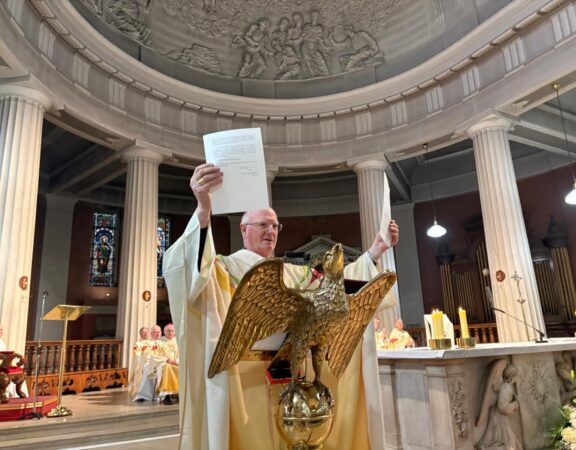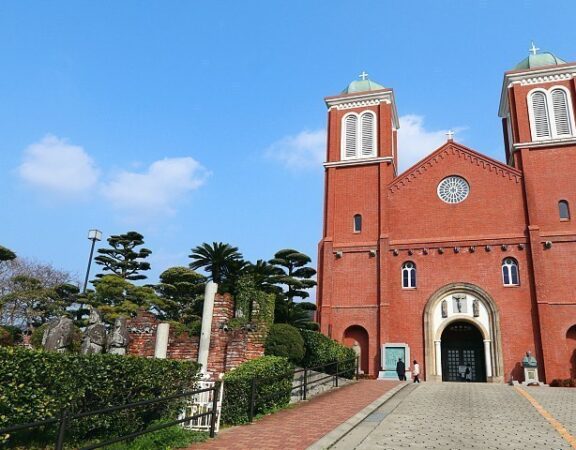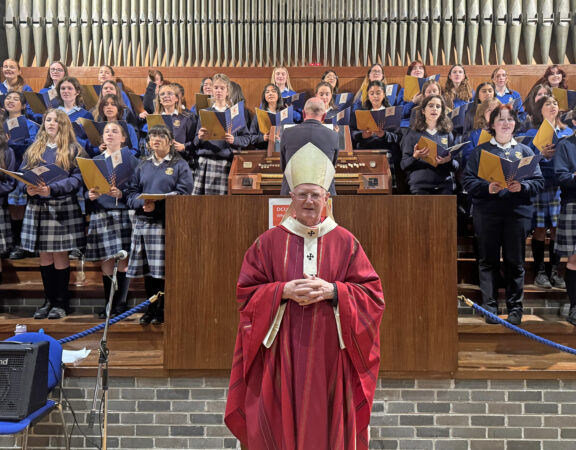Feast of All Saints 2009
OPENING OF THE CHURCH OF THE HOLY ROSARY, BALLYCRAGH
OPENING OF THE CHURCH OF THE HOLY ROSARY, BALLYCRAGH
Homily Notes of
Most Rev. Diarmuid Martin
Archbishop of Dublin and Primate of Ireland
———–
Ballycragh, 1st November 2009
Most Rev. Diarmuid Martin
Archbishop of Dublin and Primate of Ireland
———–
Ballycragh, 1st November 2009
There is something very significant in celebrating the Dedication of a new church building on the Feast of All Saints. At a time in autumn when the harvest has been collected, the Church celebrates and reminds us of the great harvest of goodness and holiness which is represented by the saints who have gone before us, the harvest of the fruits that have sprung from the presence of the love and the grace of the Lord among us in the lives of his faithful people.
The Church is a building, but it is also the community of those who make up the living Church. The bricks and mortar, the stained glass and the art works of a Church are worth little if they are not accompanied by the concrete works of Christian charity and care, of transmitting from generation to generation what it means to do good to and avoid sin, to be truly loving people and to build up a believing community that is caring.
Church is communion. It is the communion of all the saints. It is the communion of those who are brought together and who remain together in unity, by power of the Holy Spirit through sharing in the body and blood of Jesus Christ.
If the Church is communion of the saints then today’s feast is the feast of community. The Church must be a true witness to a life of community and solidarity. The Church must be the community where the true answers are found to the loneliness and isolation which beset the hearts of many.
Jesus is the vine and we are the branches. Jesus cares for the branches which are attended to and pruned with love and so come to bear the best fruit. That fruit however appears in bunches not just isolated grapes. Being a Christian means belonging to a communion; you cannot be an isolated Christian, just caring for and thinking about yourself. You cannot be a book Christian, sitting at home reflecting on the teaching of Jesus. Jesus did not leave us just with a text or a message. Christians from the very first moments of the Church have come together to celebrate the Eucharist and together to reflect on the teaching and to share the love of Jesus. We see that in the Acts of the Apostles.
The Communion of Saints is about the link with those who have gone before us, but the doctrine of the Communion of the Saints also demands that we look towards those who are beside us. It demands that we become saints to those around us – our children, our spouses, our community, our society – showing what it means to be the Church, what it means to witness to the love of God revealed in Jesus Christ. The Christian cannot simply live as if God did not exis, but must live his or her life on a different level, taking our distance from the shallowness of worldly standards, living as Jesus did.
That is the meaning of the Gospel text that is proposed to us, that of the Beatitudes. The logic of the Beatitudes is different to the logic of the world where success, celebrity and wealth are so often looked on as the face of achievement, while we know that there are so many times when the successful, the earthly and the celebrity suffer an inner emptiness and continually search for true value and worth. The Church must be a community of Beatitude Communities, open to and attracting younger people, whose idealism and generosity can easily become trapped in false ideals of where value and worth lie in their lives.
The Feast of All Saints is not about the other world. It is not a backward looking feast. It is about the way we live today.
The future of humanity depends on how we live today; our world reaps the fruits of how people live already in this life: hated, jealousies, unfaithfulness, violence, greed and corruption lead to the disintegration of community. We have seen that in the current economic crisis. The values of the Beatitudes, on the other hands, establish the conditions for realising kingdom of God in the future.
The future of humanity depends on how we live today; our world reaps the fruits of how people live already in this life: hated, jealousies, unfaithfulness, violence, greed and corruption lead to the disintegration of community. We have seen that in the current economic crisis. The values of the Beatitudes, on the other hands, establish the conditions for realising kingdom of God in the future.
The Beatitudes do not encourage us to sit back and do nothing. They offer us hope and encouragement to face the future. There is no stereotype of a saint. Saints are so varied. Each of us has our favourite saints, the ones which speak to our lives. Today’s feast shows us through the example of the saints that holiness is possible, that it is something real and that is in fact the fundamental call of each Christian and of each person. If as human beings we are created in God’s image, then being fully a human person in its essence means realising that image more fully in our lives: it means that we are called to holiness and can be holy.
Jesus shows us the way; he is the one who really experienced poverty and affliction; he was mild, humble of heart; he showed what it means to hunger and thirst for justice. He is the one who shows us what it means to be merciful, pure in heart and to work for peace. The way to holiness is the way that was led by Jesus Christ himself; he himself is the way.
This new Church building is the fruit of a great community effort. It is the fruit of the desire of this Christian community here in Ballycragh and the neighbourhood to have a Church which is truly worthy of the worship of God. I congratulate the community on its determination in bringing this Church building to this stage. I congratulate the architects, the builders and especially the hand workers. I thank the parish support groups. As one of my predecessors used to remind me, the Cathedral of Chartres was not built in one day. Over time its beauty was added to and brought to perfection. I am sure that in the years to come the same dedication and determination which brought us to this day will grow within the community to ensure that the building is cared for and embellished as the years develop.
The logic of the Beatitudes is not the logic of the world. The ceremony of today’s dedication of the new Church reminds us that this space is now to become a space set apart from the world for the worship of God. The ceremonies of the dedication of a Church and of an altar are among the most complex in the liturgy of the Church. The altar is consecrated and anointed. Then incense is placed on the altar as a sign of it being set apart, becoming a particular space dedicated to God, where God’s actions take place within the reality of our lives and community.
Parish is the place where people learn of the love of God, where they experience that love and where they try to reflect that love in their lives, in their families, in their communities, in broader society.
The Eucharist is the place where Church community is formed. Eucharist is the food which nourishes us. Eucharist is the place where we are brought together in unity by the Holy Spirit, into that deeper unity of the one Body of Christ, and with the Father who is the source of all holiness. Today we dedicate this Church of the Holy Rosary for the worship of God; we anoint the altar where the sacrifice of the Lord is recalled and from where the community returns into the world renewed.







